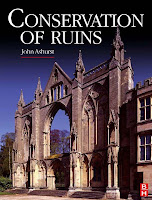J. Ashurst
Butterworth-Heinemann | 0750664290 | 2006 | PDF | 389 pages | 25 Mb

DESCRIPTION
Despite growing international awareness of the presence and significance of ruined buildings and archaeological sites, and the increasingly sophisticated technology available for the collection of data about them, these sites continue to be at risk across the globe. Conservation of Ruins defines and describes these risks, which range from neglect, to destructive archaeology, and even well-meaning intervention in the name of tourism. The book provides detailed, practical instruction on the conservation and stabilisation of ruins by structural and non-structural means, as well as describing the procedures and conditions that need to be in place to ensure the protection of our important historic sites. In considering aspects of architectural conservation, archaeology and ecology together for the first time, this book provides an integrated, holistic view of this international topic that will be essential reading for those working in this field
LIST OF CONTENT
Introduction Ruins and their landscapes
Implementation of a philosophy
Survey and assessment
Structural condition
Masonry consolidation
Surfaces at risk
Re-burial and enclosure
Flora and fauna
Case study – Herods northern palace, Masada,
Israel Case study – Guildford Castle,
UK Case study – Gosport Railway Terminal,
UK Specifying work on ruined buildings
The contractor and ruined buildings
Training for the conservation of ruins Interpretation and display of ruins
Bibliography
Index
EDITORIAL REVIEW
"John Ashurst's book is well illustrated, and contains several fascinating and diverse case studies. How do you preserve the 2,000-year-old walls of Israel's Masada? Or, closer to home, the 3m-thick walls of Guildford's 900-year-old Norman castle? Gosport's war-damaged rail terminus makes an intriguing study too and, together with several others projects, these in-depth but very readable examinations is a real enhancement of the whole subject.
Space is given to enunciating conservation principles, which are developed by the contributors into safe practices in a range of fields. Examples are cited throughout, and working methods are described and sketched. The many reasons for movement in structures are examined, as is the ecological impact of Old Brock and his many friends, both above and below the water table.
This is a delightfully illustrated book on a subject that is of as much interest to the layman with an interest in preserving our built heritage as it is to the professional and would-be professional conservator. The book is a delight."
Ecclesiastical & Heritage World
Butterworth-Heinemann | 0750664290 | 2006 | PDF | 389 pages | 25 Mb

DESCRIPTION
Despite growing international awareness of the presence and significance of ruined buildings and archaeological sites, and the increasingly sophisticated technology available for the collection of data about them, these sites continue to be at risk across the globe. Conservation of Ruins defines and describes these risks, which range from neglect, to destructive archaeology, and even well-meaning intervention in the name of tourism. The book provides detailed, practical instruction on the conservation and stabilisation of ruins by structural and non-structural means, as well as describing the procedures and conditions that need to be in place to ensure the protection of our important historic sites. In considering aspects of architectural conservation, archaeology and ecology together for the first time, this book provides an integrated, holistic view of this international topic that will be essential reading for those working in this field
LIST OF CONTENT
Introduction Ruins and their landscapes
Implementation of a philosophy
Survey and assessment
Structural condition
Masonry consolidation
Surfaces at risk
Re-burial and enclosure
Flora and fauna
Case study – Herods northern palace, Masada,
Israel Case study – Guildford Castle,
UK Case study – Gosport Railway Terminal,
UK Specifying work on ruined buildings
The contractor and ruined buildings
Training for the conservation of ruins Interpretation and display of ruins
Bibliography
Index
EDITORIAL REVIEW
"John Ashurst's book is well illustrated, and contains several fascinating and diverse case studies. How do you preserve the 2,000-year-old walls of Israel's Masada? Or, closer to home, the 3m-thick walls of Guildford's 900-year-old Norman castle? Gosport's war-damaged rail terminus makes an intriguing study too and, together with several others projects, these in-depth but very readable examinations is a real enhancement of the whole subject.
Space is given to enunciating conservation principles, which are developed by the contributors into safe practices in a range of fields. Examples are cited throughout, and working methods are described and sketched. The many reasons for movement in structures are examined, as is the ecological impact of Old Brock and his many friends, both above and below the water table.
This is a delightfully illustrated book on a subject that is of as much interest to the layman with an interest in preserving our built heritage as it is to the professional and would-be professional conservator. The book is a delight."
Ecclesiastical & Heritage World

